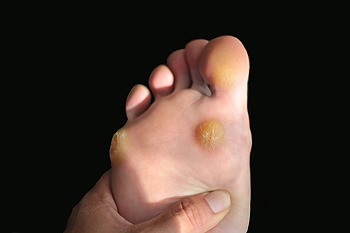 A corn will typically develop as a result of excessive pressure. They can emerge between the toes, or on the bottom of the feet. Corns are described as a small area of skin that has become hardened, and can often be painful and uncomfortable. This ailment may be caused by wearing shoes that do not fit correctly, or from medical conditions that can include hammertoes or bunions. Hard corns typically develop on the top of the outer three toes, and soft corns will form between the toes. Walking may also become difficult when a corn has formed. Some patients have found relief by wearing small pads over their corns, which may help to ease the friction. In addition, covering the corn and wearing shoes that leave ample room for the toes to move freely in, can also be helpful in alleviating some of the pain. If you are afflicted with a corn, it is strongly suggested that you consult with a podiatrist who can recommend proper corn removal options for you.
A corn will typically develop as a result of excessive pressure. They can emerge between the toes, or on the bottom of the feet. Corns are described as a small area of skin that has become hardened, and can often be painful and uncomfortable. This ailment may be caused by wearing shoes that do not fit correctly, or from medical conditions that can include hammertoes or bunions. Hard corns typically develop on the top of the outer three toes, and soft corns will form between the toes. Walking may also become difficult when a corn has formed. Some patients have found relief by wearing small pads over their corns, which may help to ease the friction. In addition, covering the corn and wearing shoes that leave ample room for the toes to move freely in, can also be helpful in alleviating some of the pain. If you are afflicted with a corn, it is strongly suggested that you consult with a podiatrist who can recommend proper corn removal options for you.
If you have any concerns regarding your feet and ankles, contact Leonora Fihman, DPM of California. Our doctor will treat your foot and ankle needs.
Corns: What Are They? and How Do You Get Rid of Them?
Corns can be described as areas of the skin that have thickened to the point of becoming painful or irritating. They are often layers and layers of the skin that have become dry and rough, and are normally smaller than calluses.
Ways to Prevent Corns
There are many ways to get rid of painful corns such as wearing:
- Well-fitting socks
- Comfortable shoes that are not tight around your foot
- Shoes that offer support
Treating Corns
Treatment of corns involves removing the dead skin that has built up in the specific area of the foot. Consult with Our doctor to determine the best treatment option for your case of corns.
If you have any questions please feel free to contact our offices located in Encino and Brentwood, Los Angeles, CA . We offer the newest diagnostic and treatment technologies for all your foot and ankle needs.
